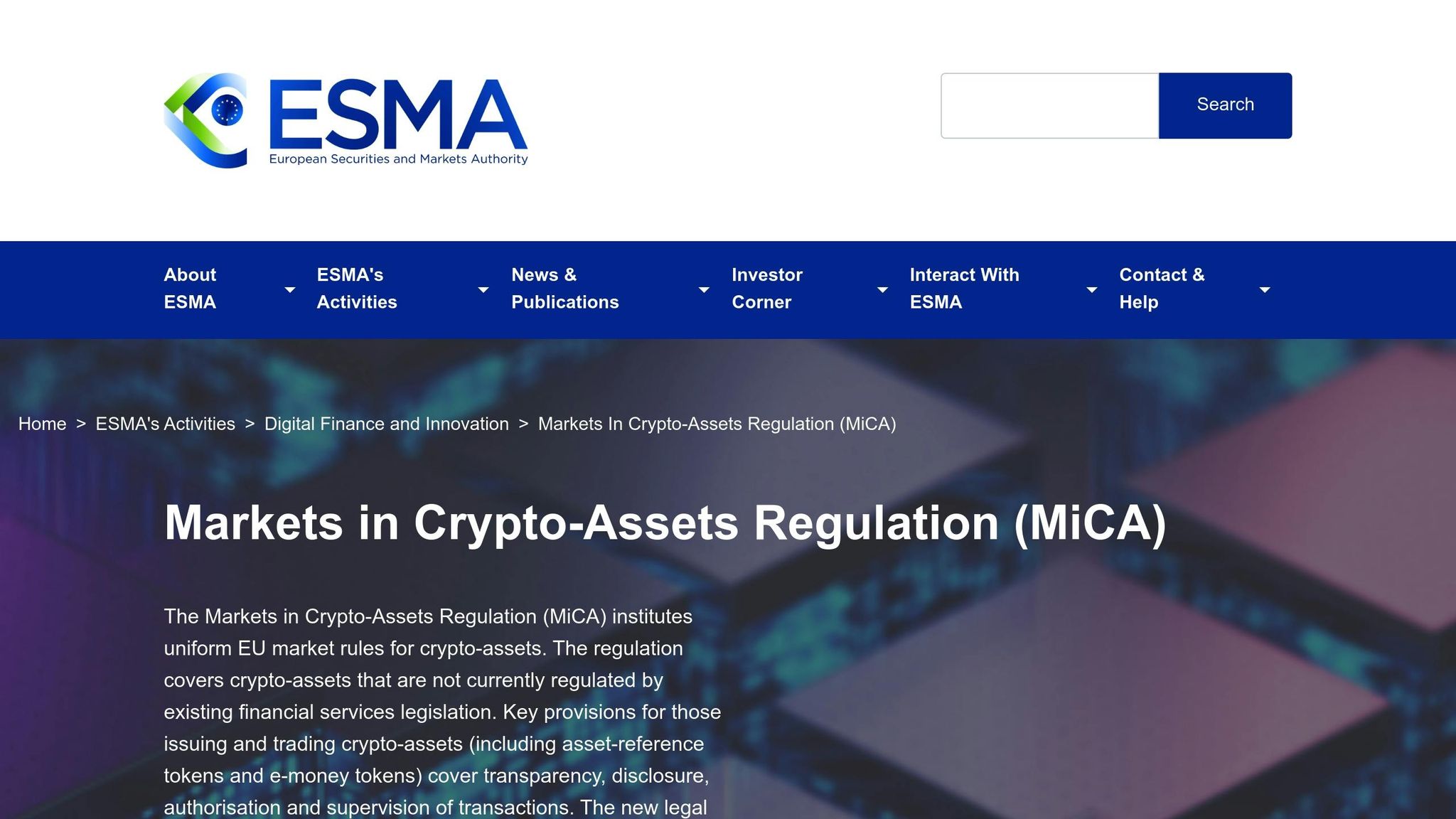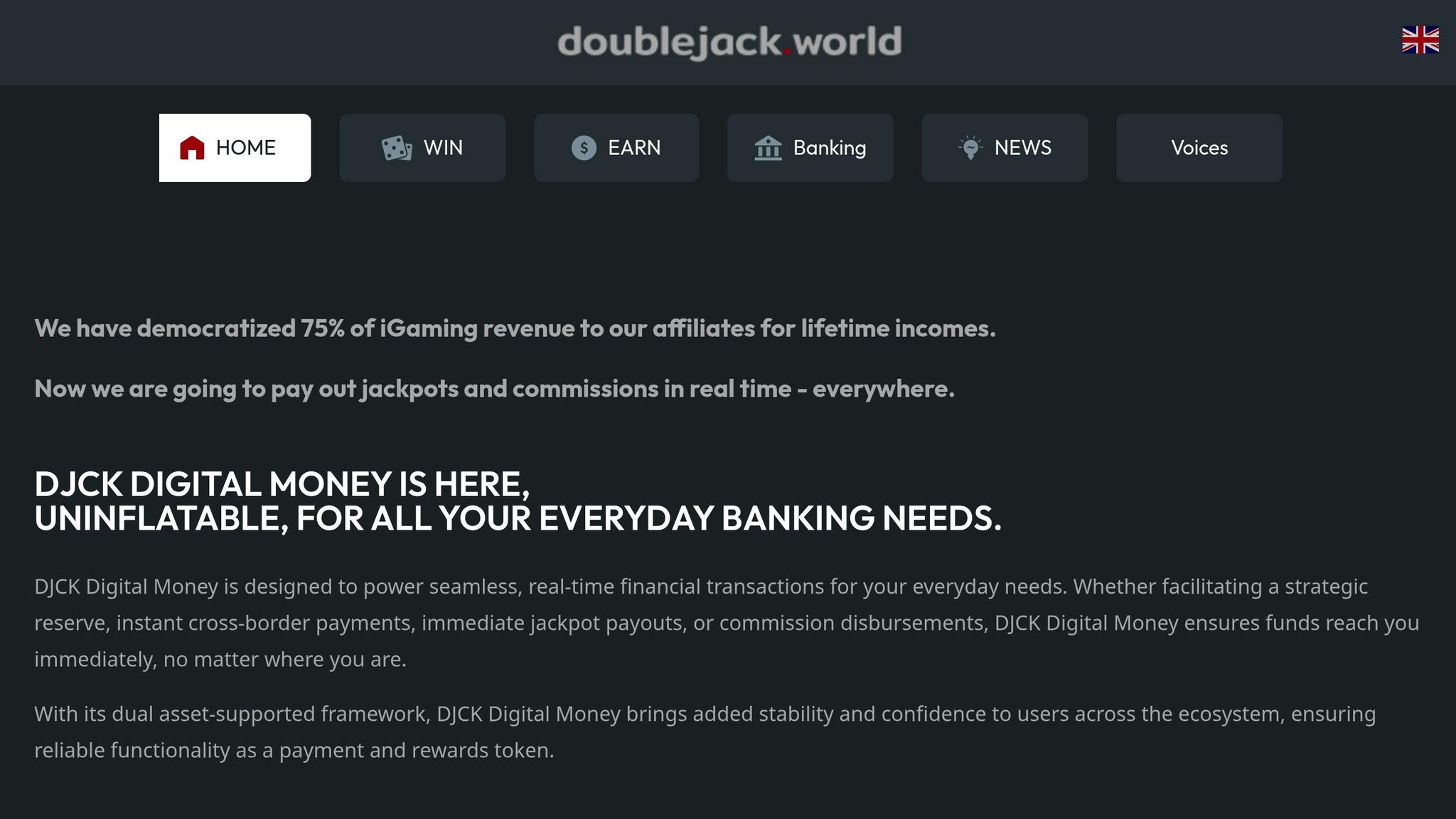
Tokenized Rewards and MiCA Rules
MiCA regulations are reshaping gaming tokens in the EU, requiring platforms to comply with strict rules on transparency, security, and user protection. Here's what you need to know:
- MiCA Overview: The Markets in Crypto-Assets (MiCA) regulation, effective EU-wide by December 2025, governs tokenized rewards in gaming.
- Token Categories:
- Asset-Referenced Tokens: Backed by assets like gold or revenue.
- E-Money Tokens: Pegged to fiat currencies.
- Utility Tokens: Used within games, with limited transferability.
- Key Compliance Steps:
- Publish detailed whitepapers.
- Implement KYC/AML processes.
- Conduct audits and manage reserves securely.
- Maintain strong cybersecurity measures.
- Gaming Tokens: Platforms must define token roles, secure smart contracts, and monitor transactions to meet MiCA standards.
- doublejack DJCK Digital Money: A dual-asset model backed by gold reserves and iGaming revenue, showcasing compliance with MiCA while ensuring stability and user safety.
Benefits: Regulatory clarity, user trust, and operational stability.
Challenges: High costs, complex implementation, and strict reserve requirements.
MiCA sets a clear path for gaming platforms to integrate blockchain rewards while ensuring compliance and user protection.
How MiCA regulation will impact the future of iGaming

MiCA Rules and Compliance Requirements
The Markets in Crypto-Assets (MiCA) regulation provides clear guidelines for classifying digital assets, including gaming tokens. Tokens are grouped based on their functionality and use cases, which determine the compliance and operational standards required under MiCA.
Asset Classification Requirements
Under MiCA, gaming tokens generally fall into three main categories:
- Asset-Referenced Tokens: These are backed by a mix of assets. For instance, doublejack DJCK Digital Money employs a dual-asset model to efficiently meet these criteria.
- E-Money Tokens: These maintain a stable value by being pegged to fiat currencies.
- Utility Tokens: These are in-game items that primarily function within the gaming ecosystem and often have limited transferability.
Once classified, tokens are subject to strict compliance measures.
Compliance Measures
MiCA enforces several requirements, including:
- Detailed whitepapers
- Comprehensive KYC/AML procedures
- Regular audits
- Asset segregation
- Strong cybersecurity protocols
Platforms must also meet minimum capital requirements based on token classification and prepare business continuity plans to ensure operational resilience.
Reserve Management Guidelines
For asset-referenced tokens, MiCA has stringent rules for reserve management. Issuers are required to fully back tokens with liquid, high-quality assets, ensure secure storage, and conduct regular reviews and reporting.
Gaming platforms must enhance their infrastructure, strengthen compliance systems, and provide transparent documentation for their tokens. These steps are also crucial for aligning with ISO 20022 standards for cross-border operations.
1. Gaming Token Requirements
Under MiCA, gaming tokens must adhere to specific rules based on their role within gaming ecosystems. These rules address classification, technical measures, and operational boundaries.
Classification Status Requirements
Gaming tokens need to clearly define their purpose by:
- Documenting value transfers between players and the platform
- Explaining their role in gaming mechanics
- Ensuring compatibility across multiple gaming environments
Technical Compliance Steps
Once token roles are defined, platforms must implement strong technical safeguards:
- Smart Contract Security
- Conduct regular third-party audits
- Include pause and upgrade mechanisms
- Use multi-signature controls for critical functions
- Transaction Monitoring
- Track token movements in real time
- Automatically flag unusual activity
- Integrate with existing anti-money laundering (AML) systems
- Data Management
- Safeguard transaction histories
- Handle user data in compliance with privacy laws
- Establish backup and recovery systems
These measures help set clear operational limits and protect users.
Permitted Activities Framework
This framework establishes operational boundaries for gaming tokens:
| Activity Type | Permitted Scope | Restrictions |
|---|---|---|
| In-Game Trading | Player-to-player exchanges | Limited to the platform ecosystem |
| External Transfers | Listings on regulated exchanges | Must maintain a complete audit trail |
| Reward Distribution | Performance-based allocation | Subject to daily distribution limits |
Platforms must document token mechanics, enforce Know Your Customer (KYC) procedures, and keep detailed records of token transactions. Automated systems should monitor token velocity, concentration, and usage patterns to ensure compliance with MiCA regulations while keeping operations efficient.
Additionally, platforms are required to maintain enough liquidity reserves and establish clear processes for managing technical problems or disputes related to tokens.
sbb-itb-4720f98
2. doublejack DJCK Digital Money Framework

The doublejack DJCK Digital Money system aligns with MiCA standards by using a dual-asset model and an efficient blockchain setup.
Asset Classification Structure
- Gold Reserve: Physical gold reserves provide stability for the token's value.
- iGaming Revenue: Revenue from iGaming activities adds an additional layer of financial stability.
- Transaction Types: Handles payments, jackpots, and commissions systematically.
This structure helps meet MiCA's technical and operational guidelines.
Compliance Implementation
doublejack DJCK Digital Money ensures it meets regulations through specific, measurable actions:
| Compliance Area | Implementation | MiCA Requirement |
|---|---|---|
| Transaction Processing | Real-time monitoring using ISO 20022 | Transparent tracking |
| Asset Verification | Dual-asset validation system | Clear value basis |
| Global Operations | Coverage in over 190 countries | Cross-border consistency |
| Digital Wallet Security | Multi-layer authentication protocols | User protection |
Operational Framework
The operational approach turns MiCA standards into practical processes:
1. Transaction Management
Financial transactions are handled through blockchain-verified channels, ensuring audit trails and full compliance with regulations.
2. Asset Support System
The dual-asset model ensures stability by combining:
- Gold reserves for consistent value support.
- Revenue from iGaming activities.
- Ongoing value tracking mechanisms.
3. User Protection Measures
User security is prioritized through:
- Advanced security for digital wallets and co-branded cards.
- Verification processes within the NFT marketplace.
- Safety controls for tokenized fan engagement.
This operational framework ensures compliance with regulations while delivering reliable service across its global network.
Benefits and Limitations
MiCA regulations bring both advantages and challenges to gaming tokens. These rules provide clear benefits but also introduce operational hurdles when it comes to regulatory compliance.
| Aspect | Benefits | Limitations |
|---|---|---|
| Regulatory Compliance | • Clear operational guidelines • Better user protection • Standardized reporting processes |
• Complex implementation steps • Increased operational costs • Lengthy approval timelines |
| Asset Management | • Transparent value tracking • Enhanced security protocols |
• Limited options for asset classification • Reduced flexibility in token design • Strict reserve requirements |
| Cross-border Operations | • Unified regulatory standards • Easier international transactions • Consistent compliance rules |
• Differences across jurisdictions • Regional regulatory variations • Delays in implementation timelines |
The doublejack DJCK Digital Money aligns with MiCA standards, utilizing a dual-asset model backed by gold reserves and iGaming revenue. This approach ensures stability, efficiency, and strong user protections.
1. Enhanced Stability
- Backed by gold reserves and steady iGaming revenue streams
- Continuous income flow
- Real-time monitoring for better oversight
2. Operational Efficiency
- Simplified international transactions
- Automated compliance reporting systems
- Built-in security features for seamless operations
3. User Protection
- Multi-layer authentication for added security
- Transparent asset tracking mechanisms
- Secure digital wallets for safe storage
These features create a system that balances regulatory compliance with operational needs, ensuring both efficiency and user satisfaction under MiCA guidelines.
Conclusion
MiCA regulations are transforming how gaming tokens and rewards function in the EU by setting clear rules that prioritize user protection and market stability. A great example of this is the dual-asset approach used by doublejack DJCK Digital Money, which combines gold reserves with revenue from iGaming to align with MiCA requirements.
This approach highlights three key aspects of MiCA compliance: detailed asset documentation, strong technical infrastructure, and strict user protections. Together, these elements show how gaming platforms can meet regulatory demands while continuing to operate efficiently.
While the initial costs of compliance might be higher, the long-term benefits - such as regulatory clarity and increased user trust - far outweigh them. By embracing these regulations early, gaming companies can position themselves for growth as the digital gaming asset landscape evolves.

